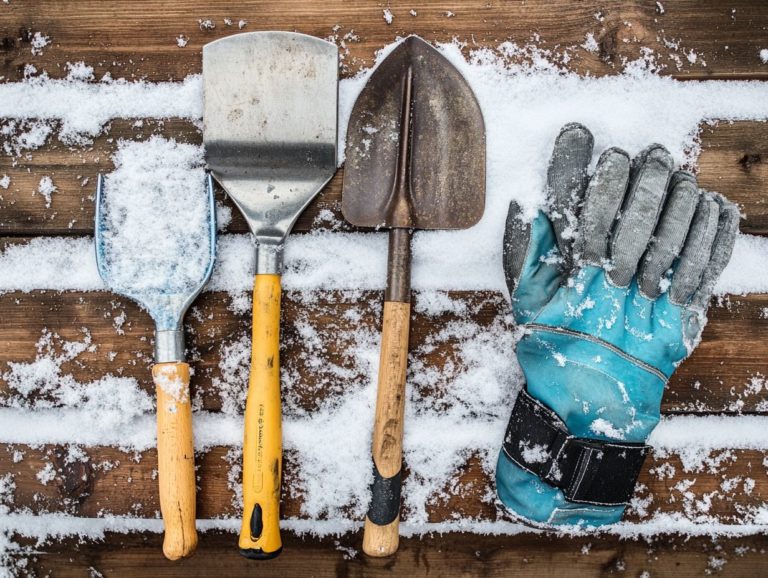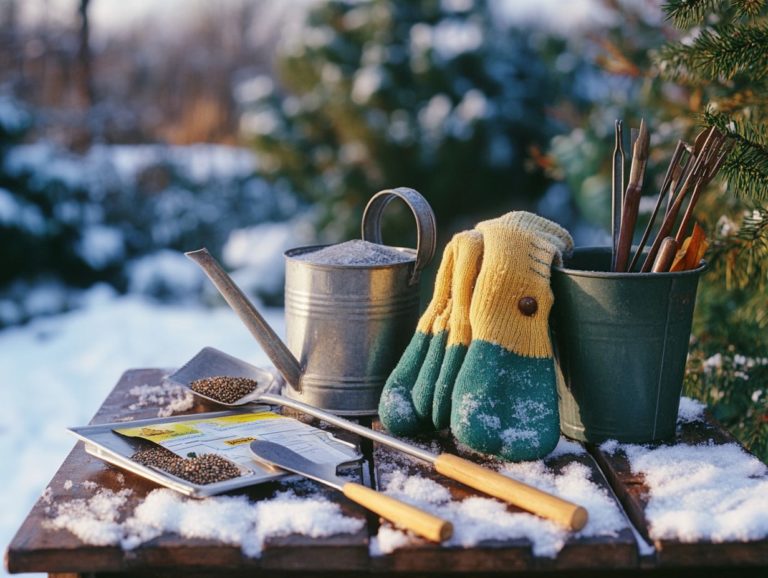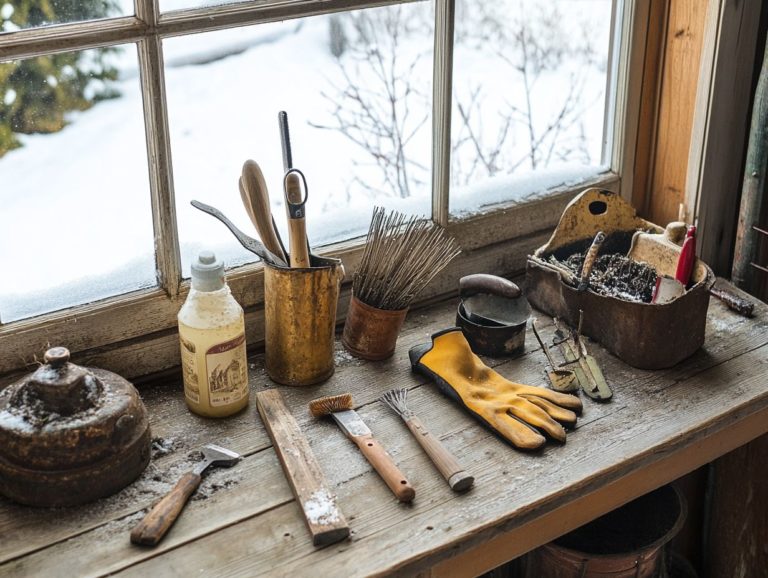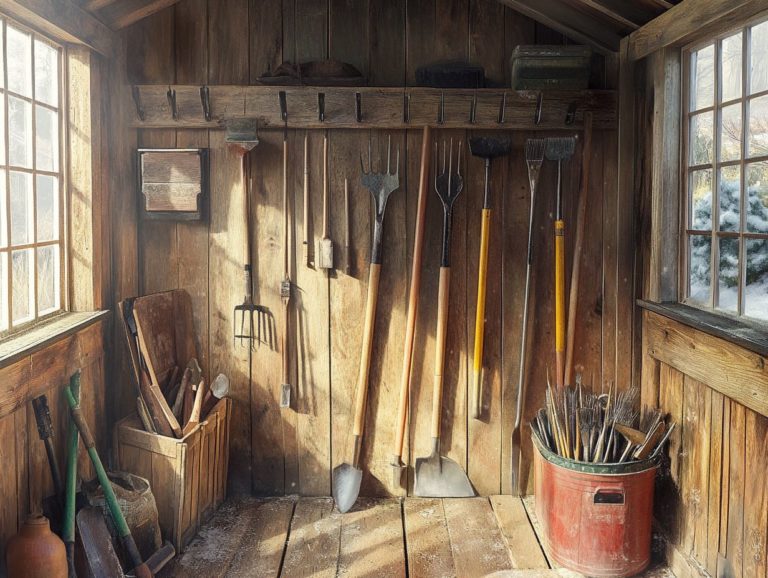The Essential Guide to Gardening in Cold Weather
Gardening in cold weather, especially in regions like Wyoming, may appear intimidating, yet it presents distinct opportunities for both you and your plants.
This guide delves into the advantages of winter gardening, providing insights on how to ready your garden for the chill while highlighting the hardiest plants that can flourish in frosty conditions.
Get ready to discover essential tools and techniques to keep your garden vibrant and productive during the winter months.
Whether you re a seasoned gardener or simply curious, there s a wealth of knowledge awaiting you in the realm of cold weather gardening.
Contents
Key Takeaways:
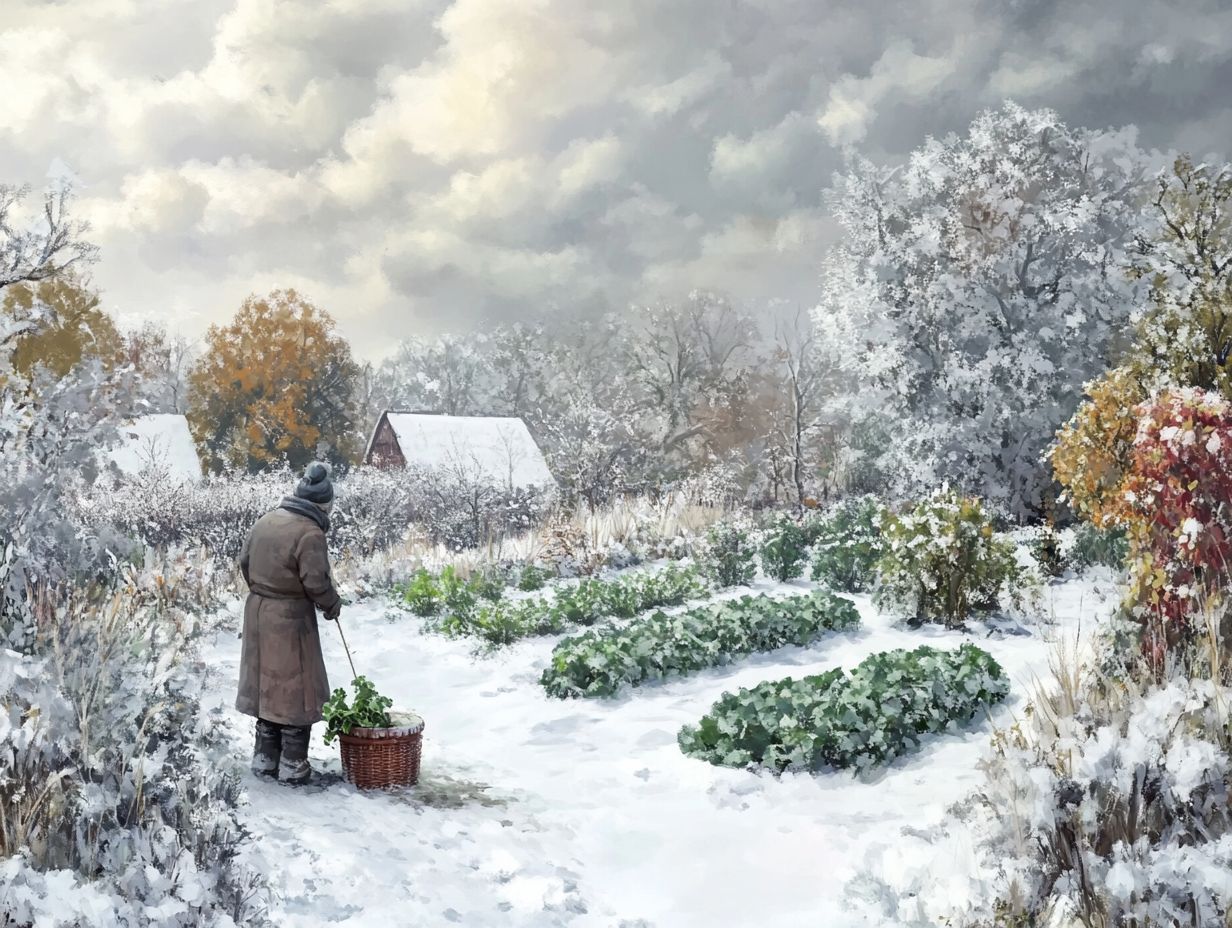
- Gardening in cold weather has numerous benefits for both plants and gardeners, including increased plant hardiness and improved mental health.
- Proper preparation and plant selection are key for successful cold weather gardening. Be sure to winterize your garden and choose hardy plants that can withstand the cold.
- Essential tools and techniques, as well as regular maintenance, are necessary for maintaining a healthy garden in cold weather. Be prepared to deal with common issues, such as frost damage.
What is Cold Weather Gardening?
Cold weather gardening is all about successfully growing plants in regions that endure harsh winters, especially in garden zone five and colder climates. This approach is particularly advantageous for you if you’re in Wyoming, where knowing the first and last frost dates becomes essential. By starting seeds indoors and selecting the right heirloom seeds, you’ll maximize your growing season, even under less than ideal conditions.
These practices boost your chances for a bountiful harvest and build resilience against the elements. You ll often encounter challenges, such as shorter growing seasons, the threat of frost damage, and a limited selection of plants that thrive in colder conditions. However, by using protective tools like cold frames, hoop houses, and row covers, you can create microclimates for gardening that offer your plants refuge from extreme temperatures.
Incorporating winter-hardy vegetables like kale, carrots, and spinach into your garden means you can enjoy fresh produce even during the colder months. Embracing the art of cold weather gardening enriches both your landscape and your gardening experience.
Benefits of Gardening in Cold Weather
Cold weather gardening offers many benefits. It allows you to cultivate nutrient-rich vegetable crops for winter during the winter months, significantly enhancing your food sustainability and ensuring you have access to fresh produce throughout the year.
Advantages for Plants and Gardeners
The benefits of cold climate gardening for both plants and gardeners are impressive. Specific winter gardening methods and gardening apps for cold climates pave the way for a more fruitful growing season.
By employing techniques like cold frames, hoop houses, and row covers, your plants can enjoy enhanced protection against harsh temperatures and moisture fluctuations, boosting their resilience and overall vitality. These methods not only shield delicate seedlings from frost but also create a microclimate, which is a small area with different climate conditions than the surrounding area, that fosters growth well into the colder months.
These strategies can significantly extend your harvest season, allowing a diverse array of vegetables and flowers to thrive, even in a chilly environment. Plus, implementing these practices can lead to fewer pests, as the controlled conditions deter many common garden invaders, resulting in a richer and healthier yield of homegrown vegetables.
Preparing Your Garden for Cold Weather
Preparing your garden for the chilly months ahead requires a thoughtful approach and involves a series of essential steps outlined by local gardening experts. By employing effective winterizing techniques, you can safeguard your plants and prolong the growing season.
Consider incorporating season extenders like cold frames and hoop houses, along with raised garden beds to enhance protection and ensure your garden thrives even in the cold.
Start planning your winter garden today to enjoy fresh produce all season long!
Steps for Winterizing Your Garden
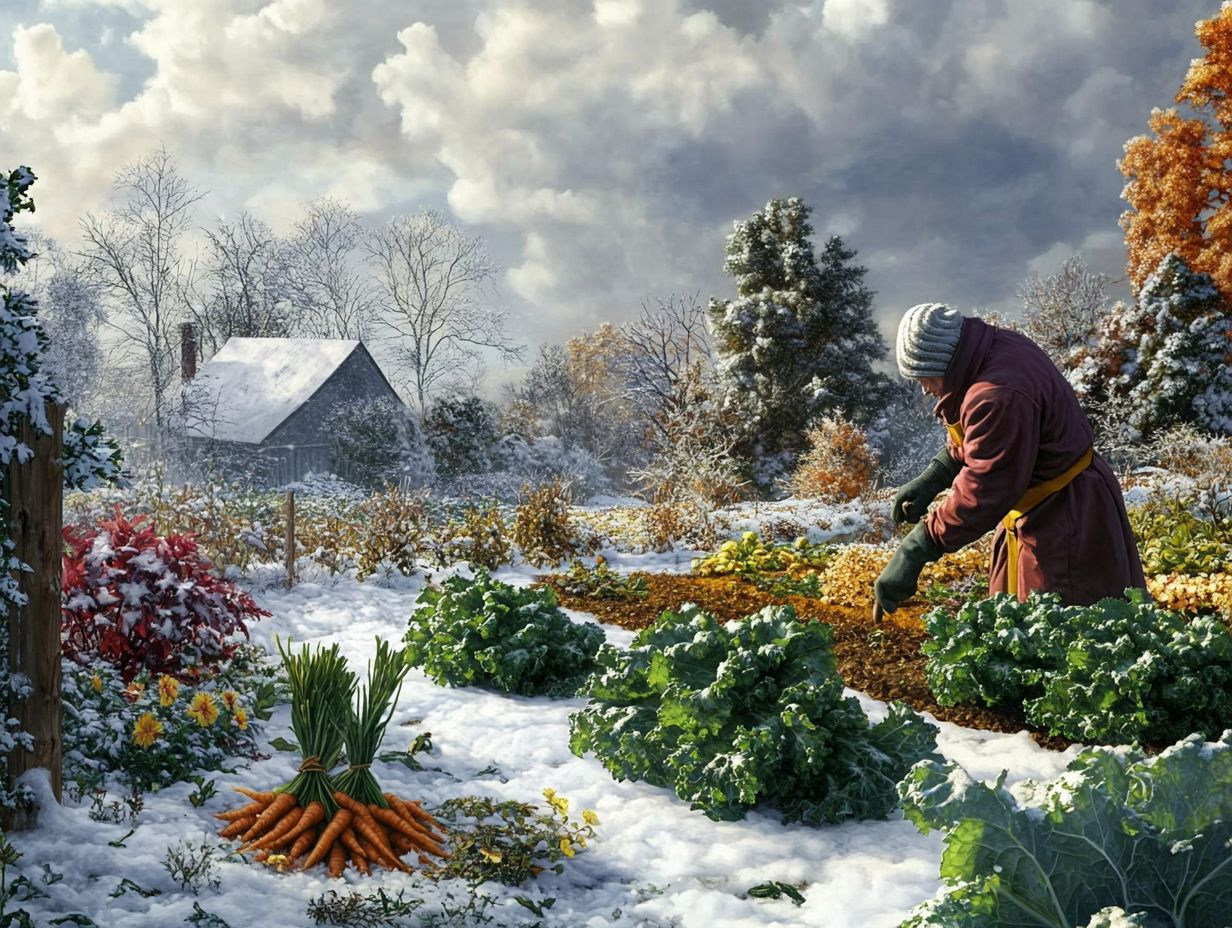
Winterizing your garden needs careful planning. Start with soil testing to check its health and implement effective frost protection to shield your plants.
- Analyze the soil pH and nutrient levels through soil testing. This allows you to make amendments before the frost.
- Once your soil is ready, focus on mulching. A layer of organic mulch insulates the soil, retains moisture, and suppresses weeds.
- Use row covers to protect delicate plants from biting winds and frosty temperatures.
- Clear away dead plant material to prevent pests and diseases this winter.
Consult gardening guides for tailored advice, ensuring your garden emerges strong and vibrant come spring!
Choosing the Right Plants for Cold Weather
Selecting the right plants is essential for gardening success. Understanding your plant hardiness map helps you choose hardy varieties like native plums and Ponderosa Pines.
Hardy Plants for Winter Gardening
Incorporate hardy plants like kale, carrots, and spinach. These options thrive even in cold temperatures, proving that winter vegetables can flourish.
These plants provide vital nutrients when fresh produce is scarce. For instance, kale survives freezing temperatures and becomes sweeter after frost!
Employ row covers and create protected garden areas to shield your plants from harsh weather, allowing them to thrive regardless of winter extremes.
Protecting Sensitive Plants
Protecting sensitive plants requires thoughtful planning. Use row covers and create sheltered areas for your herb garden.
These methods help mitigate the cold’s harsh effects and promote healthier growth. Consider windbreaks with fences or plant trees to shield delicate foliage from winter winds.
Plan for microclimates by choosing sunny locations. Place pots on porches or near sheltered walls to enhance frost protection.
Tools and Techniques for Cold Weather Gardening
Using the right tools and techniques is crucial for success in cold weather gardening. Cold frames, hoop houses, and row covers are invaluable for extending your growing season, and exploring the best cold-climate gardening books can further enhance your knowledge.
Your Must-Have Tools for Cold Weather Gardening
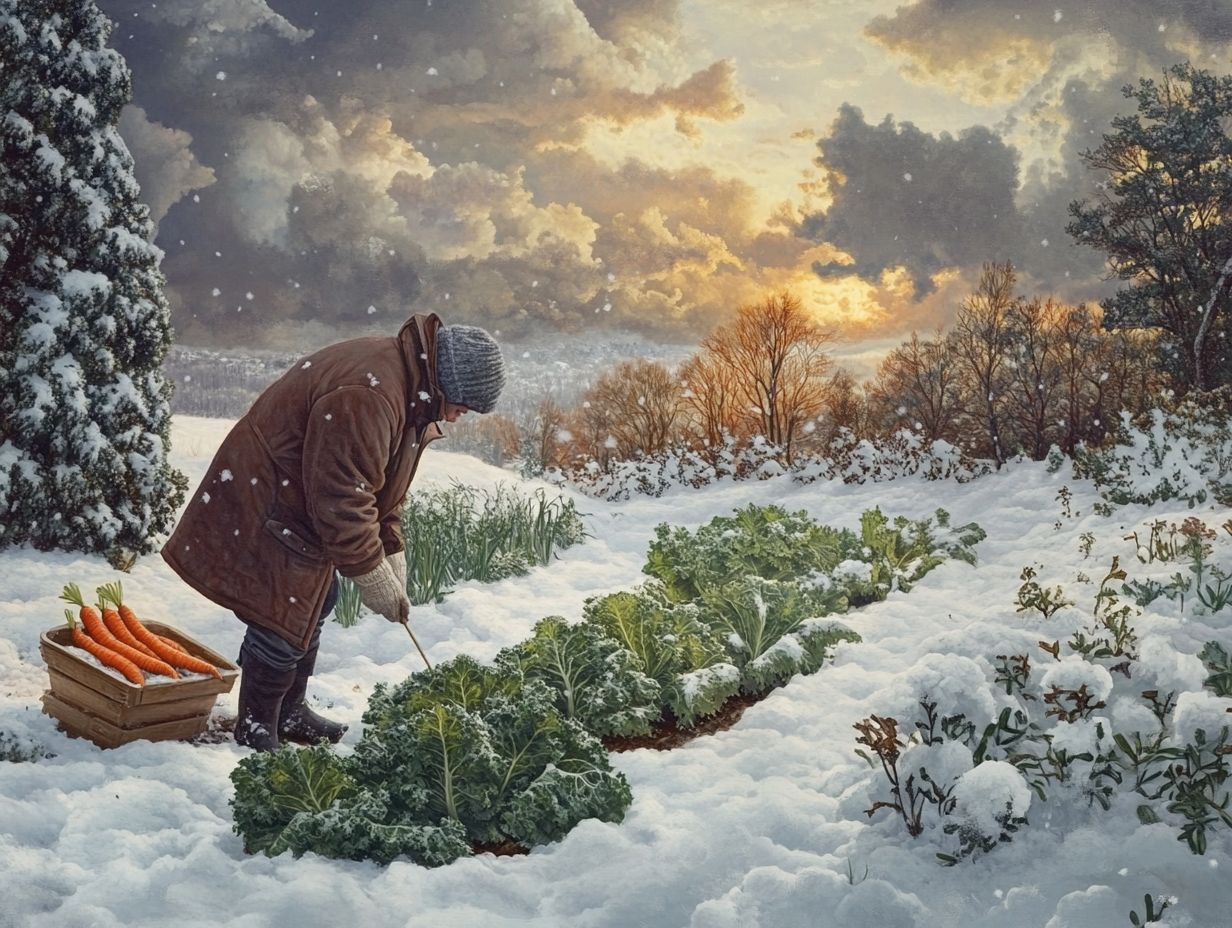
Essential tools and supplies for your cold weather gardening endeavors include insulated garden structures, protective plant covers, and dependable seed catalogs. To ensure you’re fully prepared for the season, refer to the ultimate guide to winter crop care.
These items protect your plants from cold temperatures and help them grow better in winter. This ensures a successful vegetable harvest.
Insulated structures like cold frames or greenhouses create a small area with a different climate than the surrounding area, promoting early seed germination and extending your growing season. Plant covers, such as row covers and cloches, protect your plants from frost while still allowing precious sunlight and moisture to seep through.
Reliable seed catalogs are a treasure trove of information on the best cold-tolerant varieties, enabling you to make informed decisions and maximize your yield, even when the weather throws a curveball your way.
Effective Techniques for Cold Weather Gardening
Effective techniques for cold weather gardening include using season extenders, greenhouse gardening, and innovative methods for growing vegetables indoors, allowing you to maximize your yield even in harsh conditions.
By implementing strategies like cold frames, row covers, and selecting strong plant types that survive cold weather, you can cultivate a thriving garden all year round.
Understanding the specific needs of plants in cooler temperatures such as soil temperatures and sunlight exposure can significantly boost growth and assist with vegetable preservation.
Techniques like companion planting and utilizing mulch will help you preserve soil warmth and moisture.
Carefully scheduling your planting times and taking advantage of frost dates are crucial for successful harvesting. These adaptive gardening practices not only sustain growth during chilly months but also promote long-term sustainability.
Maintaining Your Garden in Cold Weather
Maintaining your garden during the colder months requires a dedicated approach, incorporating regular maintenance tasks and utilizing the top 10 must-have tools for winter gardening that keep your plants thriving and productive.
By employing effective winter gardening techniques, you can tackle common challenges and ensure your garden remains a flourishing oasis, even in the chill of winter.
Regular Maintenance Tasks
Regular maintenance tasks are essential for your success in cold weather gardening. This includes soil testing, monitoring for pests, and reinforcing protective measures for your plants. Following winter plant care guidelines can help you tackle the challenges that winter brings.
These activities keep your soil nutrient-rich and well-aerated crucial during those chilly months and allow you to spot any pest issues early, helping you prevent larger infestations later on.
Consider implementing effective mulch options to insulate root systems, maintaining both soil temperature and moisture levels.
Frequent checks on plant health enable you to act quickly, safeguarding against common winter ailments like frostbite or rot. Ultimately, by taking a proactive approach to these vital tasks, you can cultivate a thriving garden, even as temperatures drop.
Dealing with Common Issues
Dealing with common issues in cold weather gardening, such as frost damage and pest infestations, is essential for preserving the health of your plants. To effectively manage these challenges, knowing what tools are essential for cold-climate gardening can ensure successful vegetable preservation.
As temperatures drop, you might face challenges that could jeopardize your hard work. Frost can quickly transform your vibrant greens into limp, brown remnants, while pests, in search of warmth, may invade your garden and wreak havoc among your crops.
To combat these threats, consider employing protective measures like row covers or cold frames. These can create a microclimate that shields your tender plants from frost.
Regular monitoring and implementing good pest control methods such as introducing beneficial insects or using natural repellents can significantly enhance your pest management strategies.
By understanding these seasonal challenges and proactively addressing them, you can maintain a flourishing winter garden.
Frequently Asked Questions
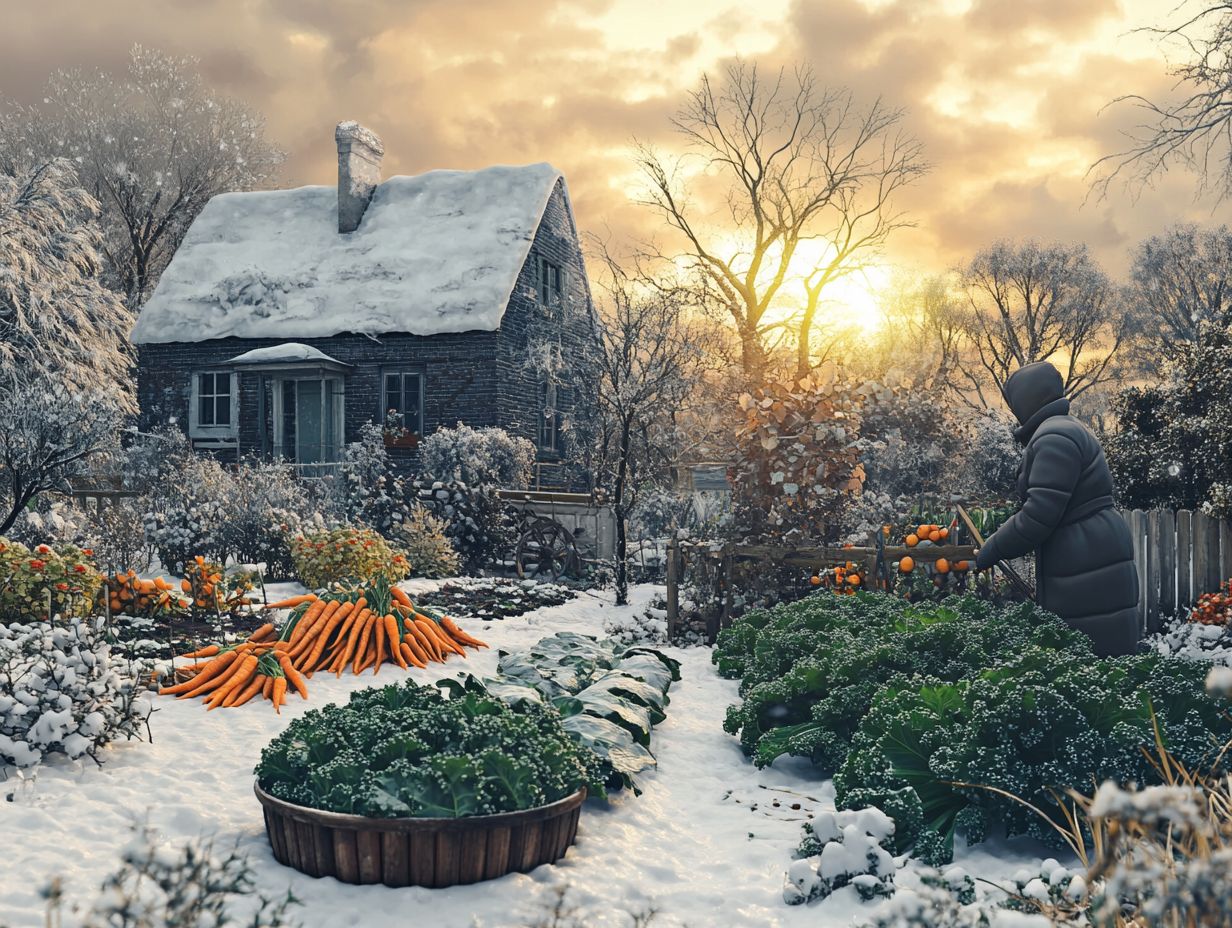
1. What are some essential tools for gardening in cold weather?
Essential tools include a shovel, rake, gloves, pruners, and a watering can.
2. How do I prepare my garden for the winter?
Prepare your garden by raking up leaves and debris. Add mulch or compost and cover sensitive plants with burlap or a cold frame.
3. Can I still grow plants in the winter?
Yes, you can grow plants in winter using a cold frame or indoor grow lights. Vegetables like kale, cabbage, and Brussels sprouts thrive in colder temperatures.
4. How often should I water my plants in winter?
Water less frequently in winter due to colder temperatures. Check the soil; water when it feels dry, but avoid overwatering.
5. How do I protect my plants from frost?
Cover plants with a sheet or blanket overnight, or use a frost cloth. Watering the soil before sunset can help keep plants warm.
6. What are some benefits of gardening in cold weather?
Gardening in cold weather controls pests and improves soil structure. It can be incredibly rewarding and provides fresh produce during winter!


